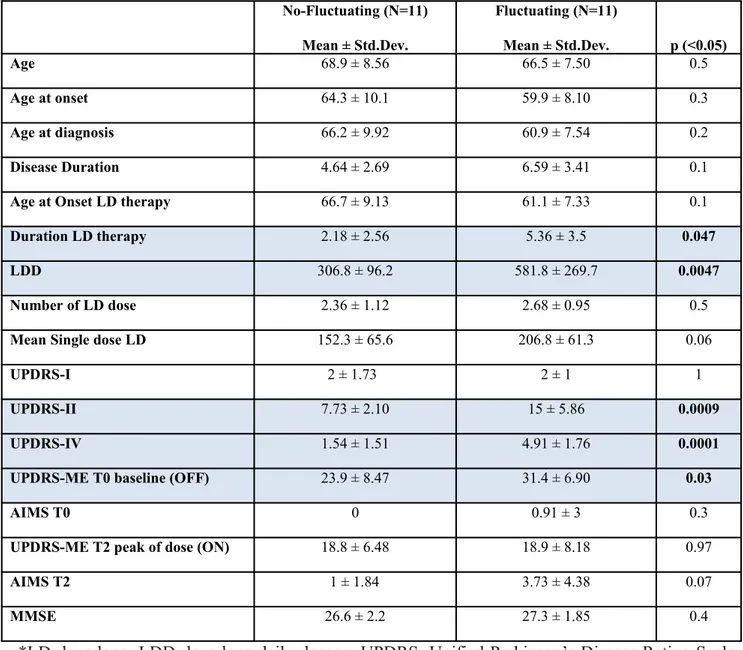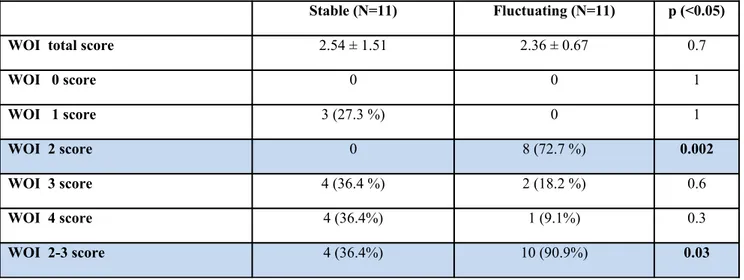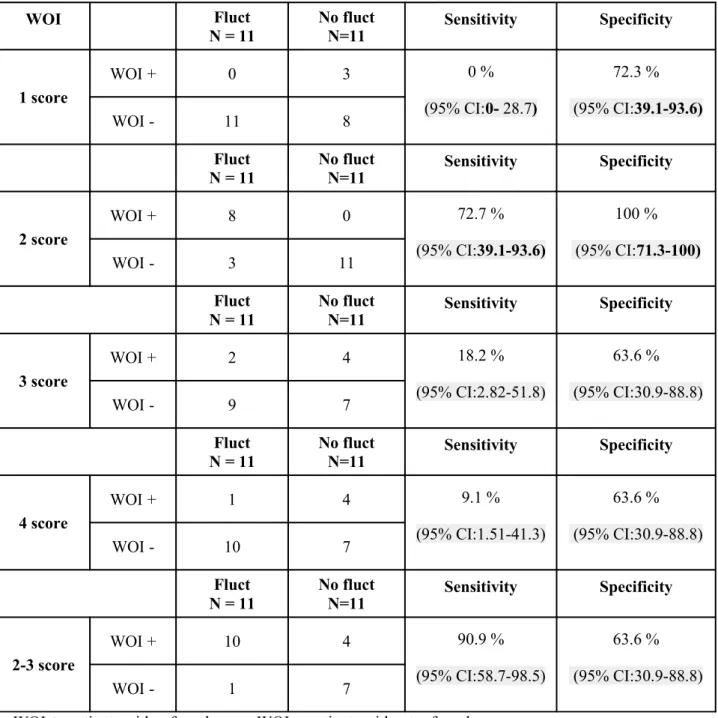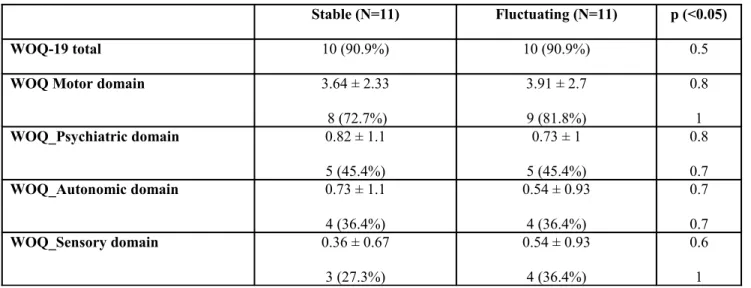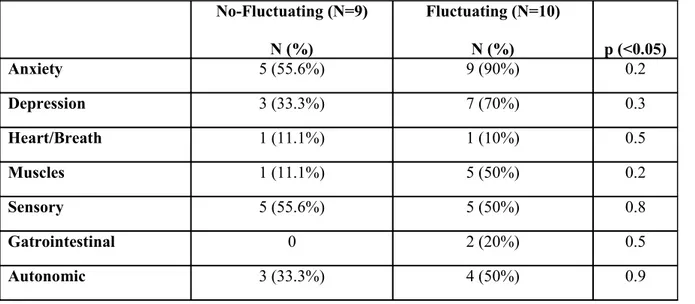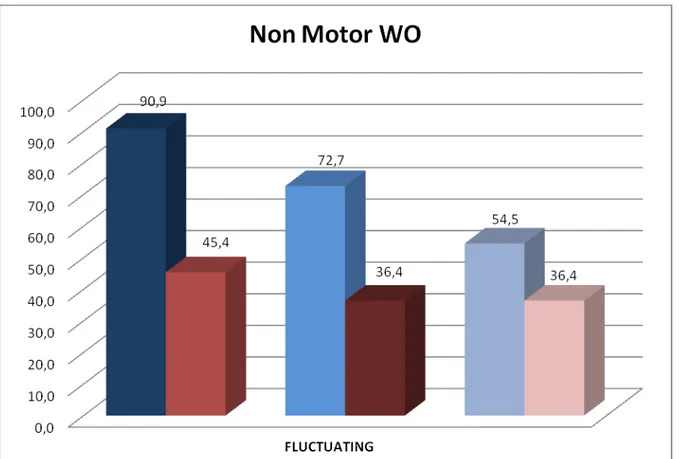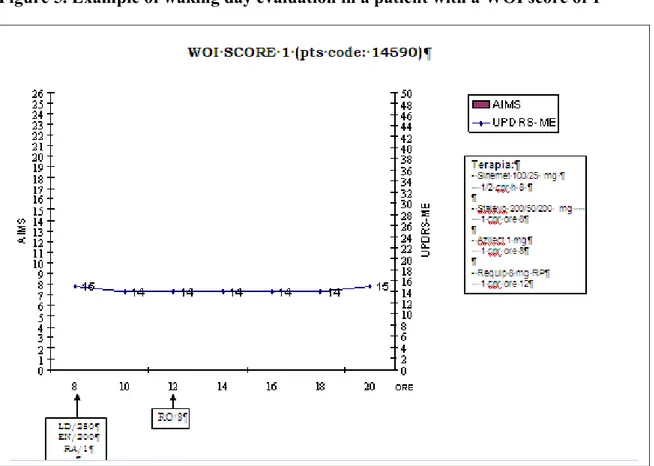UNIVERSITÀ DEGLI STUDI DI CATANIA FACOLTÀ DI MEDICINA E CHIRURGIA
DIPARTIMENTO DI NEUROSCIENZE DOTTORATO IN NEUROSCIENZE Direttore: Chiar.mo Prof. Vincenzo Perciavalle
Dott.ssa Loredana Raciti
WEARING OFF IDENTIFICATION USING CLINICAL ASSESSMENTS AND SELF-REPORTS IN PARKINSON’S DISEASE. A WAKING-DAY MONITORING STUDY
TESI DI DOTTORATO
Relatore:
Chiar.ma Prof.ssa Alessandra Nicoletti
"Il parkinsonismo è gravità, peso, la L-Dopa è lievità, assenza di peso... In un certo senso, è tutta una questione di gravità: prima ce n’è troppa, poi ce n’è troppo poca... ed è difficile trovare una via di mezzo fra i due."
INDEX Abstract
1. Introduction
2. Materials and Methods
3. Results 4. Discussion 5. References 6. Appendix 7. Tables 8. Figures
ABSTRACT
Background: Parkinson’s disease (PD) is characterized by motor fluctuations through the day due to L-dopa treatment. The wearing-off phenomenon is defined as a predictable, clinically relevant motor fluctuation which is routinely identify using clinical scales as well as self-reported questionnaires. Few studies have evaluated accuracy of such tools in identifying wearing-off using a waking-day monitoring study approach of patients motor status.
Objectives: to assess diagnostic accuracy of clinical scales as well as self-reported questionnaires compared to an objective proposed tool obtained by a 12-h motor status monitoring in PD patients.
Methods: Twenty-two PD patients were enrolled in the study. According to the item 36 of the UPDRS-ME part IV, N=11 patients were classified as fluctuating and N=11 as stable. All patients were clinically evaluated for 12 hours every 2 hours during the day and a Wearing Off Index (WOI) was computed to detect motor fluctuations. Patients also were tested using a self reported questionnaire (WOQ-19) and a 12-hours self diary (NOMO) to identify subjective perceptions of motor and non-motor fluctuations.
Results: A WOI score between 2 to 3 was able to detect a wearing-off defined by the UPDRS, with a sensitivity of 90.9% and a specificity of 63.6%. WOQ-19 was less accurate to detect a wearing-off defined by the UPDRS, with a sensitivity and specificity of 90.9 % and 27.3%, respectively. When WOI was used as gold standard, UPDRS-IV item 36 revealed a sensitivity of. 71.4 % and a specificity of 87.5 % to detect the wearing-off, while the WOQ-19 presented a sensitivity of 85.7% and specificity of 25%. According to NOMO diary, fluctuating patients showed a greater percentage of non-motor fluctuations, in particular anxiety and depression (90% and 70%, respectively) even if fluctuating non motor symptoms were also identify in stable patients.
Conclusions: our study provided some evidences about accuracy of commonly screening tools to detect wearing-off in clinical practice. A waking day monitoring approach, even if non routinely
applicable in clinical practice, may be useful to accurately assess changes in motor status through the day due to changes in pharmacological regimen.
1. Introduction
Levodopa (LD) represents the most efficacious treatment for Parkinson’s disease (PD). In the first period a significantly and sustained improvement in motor disability after dopaminergic medication (defined as “on” state) and minimal side effects are noticed. These few years are termed as the “honeymoon period”. However, after about 2 years of levodopa therapy up to 50% of patients with chronic treatment starts to experience motor complications (1). Motor fluctuations are the variable and often unpredictable complications of treatment on the symptoms in response to a dose of LD and consist of: “predictable” such as precocity decline in the duration of benefit of each dose (the so called “wearing-off” phenomenon or “end of dose deterioration”) associated with return of parkinsonian symptoms (“off” state); and “unpredictable” characterized by the rapid switching from on to off conditions (“on-off phenomenon”), decrease in the latency to onset and peak response of LD (“delayed on”), transient worsening of symptoms at the beginning of dose (“beginning of dose worsening”), exacerbation or rebound in PD symptoms at the end of dose (“end of dose rebound”), extreme exacerbation of symptoms (“super-offs”), complete absence of benefit from LD (“no-on” or “dose failure”), sudden transient freezing and abnormal involuntary movements (“dyskinesia”), (2; 3; 4). The long-term adverse reactions represent the most important cause of disability and impairment of quality of life in patients with PD (5). The therapeutic response to levodopa in PD consists of two components: the short duration response (SDR) and the long duration response (LDR) (6). The SDR is the improvement in motor disability lasting a few hours (about 4 hours) after the administration of single doses of levodopa. It has been showed that the increasing in magnitude and reducing in duration of the SDR causes development of wearing-off (7; 5; 8; 9; 10) likely due to decrement in the ability of the nigrostriatal neurons to synthesize and to store dopamine formed from exogenous precursor (11). The LDR is a sustained improvement in parkinsonian signs deriving from prolonged administration of levodopa that lasts about 1-4 weeks after discontinuation of treatment (5; 12; 13). The decline of LDR is related to the severity of disease and the duration of LD-therapy and led to the manifestation of motor fluctuations (1) but its
role in this mechanism is still unknown. Speculations deals with diminishing of the presynaptic dopaminergic compartment due to progression of PD over time (3). As the disease progresses, the duration of LDR shortens and the rate of decline in LDR after stopping levodopa increases and the response to LD becomes dominated by the SDR. Nutt et al demonstrated that after 4 years the SDR magnitude progressively increased while the LDR decayed demonstrating an inversely relationship between the two components (8). Zappia et al showed that 24% of patients lost the LDR to levodopa within the first year. Although the first signs of symptoms re-emergence are neither well established, the first motor fluctuation that is usually appreciated by the patient is the wearing-off phenomenon, precociously noticeable as “early morning akinesia”.
During the last years a greater attention has been focused on the non-motor symptoms due to the variability of signs and symptoms, as early manifestation of wearing-off periods, such as sensory manifestations, mood changes, dopamine dysregulation syndrome, gastrointestinal and autonomic symptoms that are frequently more disabling and have greater impact on PD patients’ quality of life (15; 16; 17). In particular, these are characterized by anxiety (66%), mood changes or transient cognitive decline as well as fatigue (56%), difficulty in thinking (58%), sweating (64%) akathisia (54%) (18; 19; 20). On this ground the term “motor fluctuations” may be misleading because wearing-off phenomena might be simultaneously associated to something beyond the classic motor feature of parkinsonism (21; 22): the so called “non-motor wearing-off”. Non-motor complications are often overlooked and, therefore, underestimated because of the directed attention to motor fluctuations that led to not spontaneously discuss about the full range of patients symptoms. Recognize both motor and non-motor symptoms is critical to optimize the therapy via different therapeutic options.
The widely accepted definition of wearing-off as a predictable recurrence of motor and non-motor symptoms before next scheduled doses of anti-PD medication (23) is still debated and no formal consensus definition exists. On the other hand, the predictability of the phenomena led us to differentiate it from ON–OFF phenomena, which are often unpredictable.
Nowadays the item 36 of the part IV of the UPDRS, is the screening instrument widely accepted and adopted in research studies (such as research clinical trials, RCT) and clinical practice. Recently, in order to assess the appearance of non-motor symptoms as sign of motor fluctuation, a wearing off questionnaire (WOQ) has been developed. The WOQ is a simple and rapid tool designed to detect the presence of the phenomena in PD patients. A prototype (the 32-item WOQ, WOQ-32) and two shorter versions (the 19- and 9-item WOQ, WOQ-19 and WOQ-9) were developed providing a list of motor and non-motor symptoms (24; 23; 25). According to Abbruzzese et al, the Italian version of the WOQ-19 shows a sensitivity of 88.1% and a specificity o 67.4% in detecting the WO using a cut-off of 2 positive answers (26). According to the Movement Disorder Society (MDS) systematic review of the clinometric properties of the scales used for the assessment of the wearing-off, the WOQ-19 along with the UPDRS part IV, version 3, met the criteria to be Recommended and Suggested for diagnostic screening of wearing-off. However, it should be underlined that according to both instruments, UPDRS and WOQ-19, the presence of WO is assessed just on the bases of the patients’ self-reporting. Actually the precise assessment of wearing-off in PD is more complex and in theory would require a continuous evaluation of a patient’s motor function throughout the day, not often possible outside of every research laboratories that require patients to be in a hospital or outpatient unit with continual monitoring (27; 24). Furthermore the available tools not allow to evaluate the severity of wearing-off. For this reason, with this study we tried to achieve reliable objective parameters tools with the purpose of sensibly defining and assessing the wearing-off phenomena in complicated Parkinson’s disease.
2.
Objectives
1) To develop a novel and objective tool the Wearing-Off Index, (WOI) based on 12 hours waking day monitoring in order to better detect the Motor WO.
2) To estimate the sensitivity and specificity of the WO-I versus the UPDRS part IV and the WOQ-19.
3.
Materials and Methods
36 Subjects were enrolled from patients attending the Movement Disorders Clinic at the Policlinico in Catania. All consecutively evaluated PD patients satisfied the UK Brain Bank criteria (28) and were being treated with levodopa therapy. Based on the positive or negative response to the items 36 of the UPDRS part IV (29), 25 patients were categorized as fluctuating while 11 were defined as stable. In order to better define clinical difference between the two groups 11 fluctuating patients were matched by age, gender and disease duration to the 11 stable patients. Patients who were willing to participate provided a written informed consent.
Motor Assessment
The chronic response to levodopa was evaluated as a daily assumption of standard levodopa preparations for a period of at least 3 months.
To objectively assess motor fluctuations due to LD therapy a diurnal waking day monitoring study was performed for all patients. They were evaluated from 8 am at baseline condition, after 12 hours of pharmacological wash-out, and every 2 hours lasting about 12 hours. At every time-interval the motor impairment was evaluated using the motor section of the Unified Parkinson’s Disease Rating Scale21 (UPDRS-ME, 29) and the Abnormal Involuntary Movement Scale (AIMS, 30) for dyskinesia.
Wearing-Off Index (WOI)
To quantify predictable motor fluctuations detected during the monitoring, a Wearing-Off Index (WOI) was computed based on changes in L-dopa response magnitude in the overall assessment (31). In particular, WOI was defined as the number of evaluations during the waking day monitoring based on selected time-intervals in which the “Average Magnitude” (AM) of L-dopa motor response was lower than 50%. Percent AM was computed for each assessment and time-interval as follow: (Umax - Ut) x 100 / R, where Umax = maximum UPDRS-ME detected, Ut = UPDRS-ME score at the time-interval t, R = difference between the maximun and the minimum UPDRS-ME score detected.
Clinical Assessments
We collected clinical data from the original clinical sheets. We included gender, age at assessment, age at onset of PD, disease duration of PD, levodopa daily dose, number of daily doses and mean single dose amount average of single dose, Hoehn and Yahr stage (HY), the Unified Parkinson’s Disease Rating Scale (UPDRS) part I, II and IV. Cognitive impairment was assessed by the “Mini Mental State Examination” (MMSE), using a cutoff total score of 24 or lower to detect cognitive impairment (23).
To aid the detection of motor (MF) and non-motor fluctuations (NMF), the Italian version of the Wearing Off Questionnaire-19 (WOQ-19, 25) was performed by all patients under optimal clinical conditions. The WOQ-19 is a self-reporting questionnaire that consists of 19 items assessing 9 motor symptoms (MS) and 10 non-motor symptoms (NMS). It was designed to identify not only MS/NMS, but also MF/NMF. Patients were asked to indicate whether they experienced any of the 19 symptoms during the day and whether these symptoms improved with their next levodopa medication. When patients gave “positive” answer to any item on the WOQ-19, they were identified as patients with levodopa-related fluctuations. The presence of two positive questions symptoms (cut-off ≥ 2) was used as a reliable and useful tool for detection of WO (26; 33). According to Riley
(21) to evaluate the varieties of non-motor symptoms NMS were classified into 3 categories: psychiatric (4 items in the WOQ-19 symptoms: anxiety, mood changes, panic attacks and cloudy mind/dullness of thinking), autonomic (3 items: sweating, abdominal discomfort and experiencing hot and cold), and sensory (3 items: numbness, pain and aching).
The Non-Motor wearing-Off diary (NOMO)
In order to better identify the non-motor symptoms of wearing-off we developed a 12 hours-self-assessment diary. The Non-Motor wearing-Off diary (NOMO) was based on symptoms reported on the Hamilton Rating Scale for Anxiety (34) and all patients fulfilled a 12 hours diary about signs and symptoms of mood, sensory and autonomic domain. At every time interval patients were asked to indicate whether they experienced any of the symptoms indicated in the diary (see appendix 1). As well as the WOQ-19, all non-motor symptoms were categorized into 3 domain: psychiatric (3 items: anxiety, depression and heart/breath), autonomic (2 items: gastrointestinal involvement, sweating, dizziness), and sensory (2 items: numbness, pain, aching, experiencing hot and cold, cloudy vision, fatigue). Each item is rated with a point if present and the total score was based on a seven point ordinal scale ranging from 1 to 7 at each time-interval. At every time-interval physician verified the comprehension of the patient of completing the diary. Whenever non-motor symptoms were absent or constantly present in the overall period of the waking day monitoring (score 0 or 7 for each item of the NOMO diary) the patients were considered as not fluctuating because of lack of relationship with the levodopa therapy.
Statistical analysis
Quantitative variables were described using mean ± standard deviation (SD), categorical variables using frequency (percent). Inference statistics was performed using bivariate analysis. Differences in means between groups and assessments were respectively evaluated by the independent-samples and the paired-samples t-test (2-tailed). Differences between proportion were estimated using the
chi-square test. Variations in clinical scores detected at each time-interval during the waking day monitoring were computed using the coefficient of variation (CV = SD/mean).
We estimated the sensitivity and specificity of the WOI considering both the UPDRS items 36 and the WOQ-19 as the gold standard. Furthermore, considering the WOI as an objective tool based on the variation of the motor score of the UPDRS during a 12 hours observation, we have also evaluated the sensitivity and specificity of the UPDRS and WOQ-19. 95% Confidence Intervals (CI) of sensitivity and specificity have been also computed.
4. Results
Study population characteristics
The patients were subdivided in two subgroups according to the presence of positive answers at the items 36 of the IV part of the UPDRS. Eleven non-fluctuating (stable) subjects (9 men and 2 women) were matched by age, sex and disease duration to 11 PD fluctuating patients (6 men and 6 women). Baseline characteristics (age, age at onset, age at diagnosis, disease duration, age at onset of LD therapy, mean single dose of LD, HY stage) were not significantly different between the two groups, except for a significant higher score of the duration of LD therapy (5.36 ± 3.5 vs 2.18 ± 2.56 years, p<0.047), levodopa daily dose (581.8 ± 269.7 vs 306.8 ± 96.2; p <0.05), the part II (15 ± 5.86 vs 7.73 ± 2.10; p< 0.0009) and IV (4.91 ± 1.76 vs 1.54 ± 1.51; p< 0.0001) as well as the motor section of the UPDRS at baseline conditions (31.4 ± 6.90 vs 23.9 ± 8.47; p<0.03), as shown in table 1. Variation in UPDRS-ME scores detected during the 12-h assessment and computed using CV was higher for fluctuating patients (0.26 ± 0.22 vs 0.11 ± 0.07; p = 0.049).
Accuracy of WOI respect to UPDRS-ME IV item in wearing-off detection
WOI was defined as the number of evaluations during the waking day monitoring based on selected time-intervals in which the AM of L-dopa motor response was lower than 50%. According to this definition in our sample the mean score of the WO-I was 2.36 ± 0.67, raging from 2 to 4, among fluctuating PD patients and 2.82 ± 1.25, ranging from 1 to 4, among stable PD patients. The relative frequency of WO-I score is reported in table 2.
We evaluated the sensitivity and specificity of each WO-I score considering the UPDRS item 36 as the gold standard as shown in table 3.
A score of 2 was found as useful tool to discriminate fluctuating from stable patients with a sensitivity of 72.7 % (95%CI: 39.1-93.6) and a specificity of 100% (95%CI: 71.3-100) while using
the range 2-3 we obtained a sensitivity of 90.9% (95%CI: 58.7-98.5) and a specificity of 63.6% (95%CI: 30.9-88.8). Variation in UPDRS-ME scores detected during the 12-h assessment and computed using CV was higher for patients with a WOI ranging between 2 to 3 (0.25 ± 0.19 vs 0.07 ± 0.04; p = 0.003).
Nevertheless, considering that the WO-I is an objective index based on the variation of the UPDRS-ME score evaluated by expert clinicians during a 12 hours waking day monitoring, it probably represents a more accurate tool in identifying the motor WO. To this reason we have also estimated the sensitivity and specificity of the UPDRS considering the WO-I as the gold standard.
Out of 11 PD patients, 4 subjects (36.4%), classified as “stable” according to the item 36 of the UPDRS, presented a WOI score between 2-3 and were consequently classified as fluctuating patients. The presence of motor WO in these 4 patients is also evident by the simple visual assessment of the waking day reported in figure 3. On the other hand 10 of the 11 patients classified as fluctuating presented a WOI of 2-3. The sensitivity of the UPDRS item 36 was 71.4 % (95%CI: 41.9-91.4) with a specificity of 87.5 % (95%CI: 47.4-97.9).
Wearing-off non-motor aspects detected by WOQ-19 and NOMO
According to the WOQ-19 out of the 22 enrolled patients, 20 (90.9%) were classified as having a WO (10 among the 11 stable patients and 10 among the 11 fluctuating patients, classified according to the item 36 of the UPDRS), The sensitivity and specificity of the WOQ-19 versus the item 36 of the UPDRS-IV, was 90.9 % (95%CI: 58.7-98.5) and 27.3% (95%CI: 6.3-60.9), using the suggested global score equal or greater than 2 based on all motor and non-motor items. A lower sensitivity and specificity was obtained when the WO-I (score 2-3) was used as the gold standard (sensitivity of 85.7 % and specificity of 25%). Surprising the frequency of positive subjects at each non motor domains was the same in both groups (stable and fluctuating) as shown in figure 1.
When the fluctuation of non-motor symptoms was evaluated using the NOMO diary we found a higher frequency of fluctuating non-motor symptoms (score 1 to 6 of the different items of the diary) in the group of the subjects classified as having a WO according to both the item 36 and the WO-I. In particular the most common fluctuating non-motor symptoms in this latter group was anxiety and depression recorded respectively in 90% and 70% of patients. Although it should be noted that a high percentage of non-motor WO was recorded also among the stable patients (eg. 55.6.% anxiety and 33.3% depression) as shown in figure 1.
5.
Discussion
The wearing-off is commonly defined as a predictable recurrence of motor and non-motor symptoms before next scheduled doses of anti-PD medication (23) even if this definition is still debated and no formal consensus definition exists. The wearing-off phenomenon could be considered an expression of the complex and advanced stage of the disease. The pathophysiological mechanism of wearing-off is still debated and has been related to a reduced pre-synaptic storage of dopamine combining to a post-synaptic involvement. By several studies, the wearing-off response is thought to result from a reduced capacity for storage for dopaminergic effect and from a change in the pharmacodynamic response, although there is no evidence that the neurotransmitter itself persists. In any case, the duration of clinical effect against parkinsonian features begins to approximate the plasma pharmacokinetics profile of dopa and, consequently, the delivery of L-dopa to the brain. On the other hand, there are little or no studies about the mechanism underlying non-motor features. An accurate identification of the motor and non-motor wearing-off is fundamental to avoid overlooked and underestimated patients discomfort. Nowadays, the most useful instruments to detect the wearing-off are essentially the physician evaluation of WO, the items 36 of the UPDRS and self-questionnaires, such as the WOQ-19 and the motor fluctuation diary. Physician assessment is as important as limited by the time-consuming nature of the counselling. Although the UPDRS part IV has been widespread used in clinical practice and research leading to an excellent comparability among centers and studies, the MDS Task Force considered the scale as a suggested tool for the rating of severity of WO (27). Among the available screening tools the WOQ is the only one considered as Recommended by the MDS (27) showing a good sensitivity and specificity when a cut-off of ≥ 2 is considered (23). However, because of the strong relationship with the capacity of the patient to be able to correctly self-identify his/her status, the scale cannot be used as rating instruments of the severity of wearing-off, and could also lead to an overestimation due to an oversensitivity of the tool in detecting the WO phenomena (24). Every single method is shortcut and practicable, but at the same time potentially important information
could be lost. For this reason we tried to identify an accurate and objective instrument to better define the WO by computing a new index based on the magnitude effect detected on changes in levodopa response magnitude during 12 hours of observation. In our study we demonstrated how the waking day evaluation could be considered as a useful and accurate tool to assess the wearing-off phenomenon.
According to our data a wearing-off index of 2 led us to identify a patient with fluctuation, classified according to the item 36 of the UPDRS-IV, with a sensitivity of 72.7 % and a specificity of 100% (p<0.001), while considering a WOI score between 2 and 3 we were able to differentiate stable from fluctuating patients with a sensitivity of 90.9% and a specificity of 72.7 %.
Nevertheless, it should be noted that four (36.4%) out of 11 PD patients classified as stable according to the item 36 of the UPDRS-IV were re-classified as fluctuating (score 2-3) according to the WOI and were clearly fluctuating as shown in figure 3. When the WOI, a more objective and accurate index to the detect the motor WO, was considered as the gold standard we obtained a sensitivity of the item 36 of the UPDRS-IV of 71.4 % (95%CI: 41.9-91.4) with a specificity of 87.5 % (95%CI: 47.4-97.9).
To the best of our knowledge this is the first attempt to evaluate the sensitivity and specificity of the item 36 of the UPDRS-IV, a widely accepted tool to detect the motor WO, versus an objective index such as the WOI. Our data show a poor accuracy of the UPDRS part IV, a tool suggested by the MDS, that miss to identify more than 35% of fluctuating patinets. It should be also underlined that this tool has been adopted in several RCTs to assess the motor WO often considered as primary or secondary endpoint in evaluating the drug efficacy.
On the other hand 20 (90.9%) out of the 22 enrolled patients were classified as fluctuating according to the WOQ 19 (10 in the stable group and 10 among the fluctuating patients ), showing a poor agreement with both the WOI index and the item 36 of the UPDRS-IV. In particular when WOQ-19 was validated using the item 36 of the UPDRS as gold standard, it has shown a very low specificity levels (sensitivity 90.9 % and specificity 27.3%). Lower sensitivity and specificity
values has been obtained when the WOI was used as gold standard (sensitivity 85.7% and specificity of 25%) The discrepancy between the WOI and the WOQ-19 might indicate an excessive sensitivity of the patient self-questionnaire (e.g., capture of non–medication-related fluctuations, 25). A further explanation could be the lack of ability of the questionnaire to distinguish between types of motor fluctuations (eg, wearing-off, sudden ON–OFF fluctuations, or delayed ON). Moreover, the possible oversensitivity and low specificity of the WOQ-19 could be explained by the common daily fluctuation of symptoms, such as anxiety or depression, not necessarily related to the LD administration and consequently non effectively related to WO phenomena. It is important to stress that this oversensitivity could lead the physician to an incorrect treatment management (e.g. increase dosage of dopaminercic drugs), when the judgement is based only on the bases of the self-reported fluctuation of the non motor symptoms such as anxiety over the day.
Concerning the non-motor symptoms evaluated with the WOQ-19 and the NOMO diary, in both cases we have identified a good proportion of patients who referred a so called non-motor fluctuation in the different explored domains. Surprisingly, the presence of “fluctuating non-motor symptoms”, and particularly those related to the neuropsychiatric domain (such as anxiety and depression), was also detected in absence of a motor WO identified according to either item 36 of the UPDRS-IV or the WOI. According to the NOMO diary fluctuating patients showed a greater, even if not significant, percentage of non-motor WO, and in particular anxiety and depression were the most common reported (90% and 70% respectively). Although an high percentage of non-motor WO was also found among the stable patients (eg. 55.6.% anxiety and 33.3% depression), according to the WOQ-19 no difference was present between fluctuating and stable group in terms of percentage of patients who reported a non-motor WO in the different explored domains as shown in table 7. According to literature data, although the re-emergence of parkinsonian motor symptoms combining to non-motor signs has been described for more than 20 years (35,36,37), it is questionable the existence of a non-motor WO alone and not accompanied by motor fluctuation.
The WOI represent the first objective index elaborated to determine the presence and the severity of a motor WO, nevertheless we are aware that several limits should be taken into account in interpreting our data. First of all this kind of evaluation is time consuming and require patients to be in a hospital or outpatient unit with continual monitoring. In addition, in clinical experience patients usually refer motor condition variation from one day to another. So as, the waking day evaluation could be not represent the real condition of the patient due to daily motor variability. Another important limit of our study is related to the WOI score. In fact, although the WOI score ranging from 1 to 4 only a score of 2-3 lead us to detect motor fluctuation with a high level of sensitivity and specificity (90.9% and 63.6%) while the lower score of 1 as well as the higher score of 4 was unable to correctly classify the fluctuating patients. This is undoubtedly due to the effect of minimal variance of the score of the UPDRS motor part during the waking day evaluation that influence the total WO-I score as shown in figure 4-6.
Finally we are aware that the precision of the estimates obtained could be affected by the small size of our study and that further studies are needed to confirm our results.
In conclusion, although a waking day evaluation is time-consuming and not applicable in daily clinical practice, our study has provided important evidence on the accuracy of the commonly used screening tools to detect the WO such as the item 36 of the UPDRS-IV and the WOQ-19. It should be noted that this tools are generally adopted in clinical research such as RCTs to measure important outcomes related to the efficacy of new drugs (e.g. CALM-PD) (38) but they are also used in the clinical practice and often guide the judgment of the clinician in the management of the therapy.
Our study has also underlined the poor specificity of the non-motor fluctuation that can also contribute to the overestimation of the real WO phenomena leading to an useful and not necessary increase of dosage of dopaminergic drug.
A waking day monitoring, however, may still represent a valid and alternative clinical approach to optimize levodopa therapy in fluctuating patients, as it may lead to correctly identify changes due to the drug throught the day.
6. References
1. Parkinson’s Study Group: Pramipexole vs levodopa as initial treatment for Parkinson Disease: a randomized controlled trial. JAMA 2000; 284: 1931-1938.
2. Fahn S. "On-off" phenomenon with levodopa therapy in Parkinsonism. Clinical and pharmacologic correlations and the effect of intramuscular pyridoxine. Neurology. 1974 May;24(5):431-41.
3. Marsden CD, Parkes JD. On-Off effects in patients with Parkinson’s disease on chronic levodopa therapy. Lancet 1976; 1: 292-296.
4. Shaw KM, Lees AJ, Stern GM. The impact of treatment with levodopa on Parkinson's disease. Q J Med. 1980;49(195):283-93.
5. Nutt JG, Holford NH. The response to levodopa in Parkinson's disease: imposing pharmacological law and order. Ann Neurol. 1996 May;39(5):561-73).
6. Muenter MD, Tyce GM. L-dopa therapy of Parkinson’s disease: plasma L-dopa concentration, therapeutic response, and side effects. Mayo Clin Proc 1971; 46:231-239.
7. Hughes AJ, Frankel JP, Kempster PA, Stern GM, Lees AJ. Motor response to levodopa in patients with parkinsonian motor fluctuations: a follow-up study over three years. J Neurol Neurosurg Psychiatry. 1994;57:430-4.
8. Nutt JG, Carter JH, Lea ES, Sexton GJ. Evolution of the response to levodopa during the first 4 years of therapy. Ann Neurol. 2002;51:686-93.
9. Zappia M, Montesanti R, Colao R, Quattrone A. Usefulness of movement time in the assessment of Parkinson's disease. J Neurol. 1994;241:543-50.
10. Zappia M, Colao R, Montesanti R, Rizzo M, Aguglia U, Gambardella A, Oliveri RL, Quattrone A. Long-duration response to levodopa influences the pharmacodynamics of short-duration response in Parkinson's disease. Ann Neurol. 1997;42:245-8).
11. Zappia M, Oliveri RL, Montesanti R, Rizzo M, Bosco D, Plastino M, Crescibene L, Bastone L, Aguglia U, Gambardella A, Quattrone A. Loss of long-duration response to levodopa over time in PD: implications for wearing-off. Neurology 1999, Mar 10;52(4):763-7.
12. Obeso JA, Rodriguez-Oroz MC, Chana P, Lera G, Rodriguez M, Olanow CW. The evolution and origin of motor complications in Parkinson’s disease. Neurology 2000; 55 (Suppl 4) S13-S20.
13. Hauser RA, Holford NH. Quantitative description of loss of clinical benefit following withdrawal of levodopa-carbidopa and bromocriptine in early Parkinson’s Disease. Movement Disord 2002; 17:961-968.
14. Nutt JG, Carter JH, Lea ES, Sexton GJ: Evolution of the response to levodopa during the first 4 years of therapy. Ann Neurol 2002; 51: 686-693.
15. Stacy M, Bowron A, Guttman M, Hauser R, Hughes K, Larsen JP, LeWitt P, Oertel W, Quinn N, Sethi K, Stocchi F: Identification of motor and nonmotor wearing-off in Parkinson’s disease: comparison of a patient questionnaire versus a clinician assessment. Mov Disord 2005; 20: 726– 733.
16. Witjas T, Kaphan E, Azulay JP, Blin O, Ceccaldi M, Pouget J, Poncet M, Cherif AA: Nonmotor fluctuations in Parkinson’s disease: frequent and disabling. Neurology 2002; 59: 408–413.
17. Lang AE, Lozano AM. Parkinson’s disease. First of two part. N Engl J Med 1998; 39:1044-1053).
18. Kulisevsky J, García-Sánchez C, Berthier ML, Barbanoj M, Pascual-Sedano B, Gironell A, Estévez-González A. Chronic effects of dopaminergic replacement on cognitive function in Parkinson's disease: a two-year follow-up study of previously untreated patients. Mov Disord. 2000 Jul;15(4):613-26.
19. Bunney WE, Janowsky DS, Goodwin FK, Davis JM, Brodie HK, Murphy DL, Chase TN. Effect of L-DOPA on depression. Lancet. 1969 Apr 26; 1(7600): 885-6.
20. Kulisevsky J, Avila A, Barbanoj M, Antonijoan R, Berthier ML, Gironell A. Acute effects of levodopa on neuropsychological performance in stable and fluctuating Parkinson's disease patients at different levodopa plasma levels. Brain. 1996 Dec;119 ( Pt 6):2121-32.
21. Riley DE, Lang AE. The spectrum of levodopa-related fluctuations in Parkinson’s disease. Neurology 1993 Aug;43(8):1459-64.
22. Ahlskog JE, Muenter MD. Frequency of levodopa-related dyskinesias and motor fluctuations as estimated from the cumulative literature. Mov Disord. 2001 May;16(3):448-58.
23. Stacy M, Hauser R, Oertel W, Schapira A, Sethi K, Stocchi F, Tolosa E. End-of-dose wearing off in Parkinson disease: a 9-question survey assessment. Clin Neuropharmacol. 2006 Nov-Dec;29(6):312-21.
24. Stacy M, Bowron A, Guttman M, Hauser R, Hughes K, Larsen JP, LeWitt P, Oertel W, Quinn N, Sethi K, Stocchi F. Identification of motor and nonmotor wearing-off in Parkinson's disease: comparison of a patient questionnaire versus a clinician assessment. Mov Disord. 2005 Jun;20(6):726-33.
25. Stacy M, Hauser R. Development of a patient questionnaire to facilitate recognition of motor and non-motor wearing-off in Parkinson’s disease. J Neural Transm 2007 Feb;114(2): 211e7.
26. Abbruzzese G, Antonini A, Barone P, Stocchi F, Tamburini T, Bernardi L, Amboni M, Vacca L, Posocco V, Colombo D. Linguistic, psychometric validation and diagnostic ability assessment of an Italian version of a 19-item wearing-off questionnaire for wearing-off detection in Parkinson's disease. Neurol Sci. 2012 Dec;33(6):1319-27.
27. Antonini A et al. Wearing-Off Scales in Parkinson’s Disease: Critique and Recommendations. Movement Disorders, Vol. 26, No. 12, 2011.
28. Gibb WR, Lees AJ. The relevance of the Lewy body to the pathogenesis of idiopathic Parkinson's disease. J Neurol Neurosurg Psychiatry. 1988 Jun;51(6):745-52.
29. Fahn S, Elton RL and the Members of the UPDRS Development Committee. Unified Parkinson’s Disease Rating Scale. In: Fahn S, Marsden CD, Calne DB, eds. Recent developments in Parkinson’s disease. London: Macmillan 1987: 153-163.
30. Rush JA Jr, Handbook of Psychiatric Measures, American Psychiatric Association, 2000, 166-168.
31. Mostile G, Nicoletti A, Dibilio V, Luca A, Raciti L, Sciacca G, Contrafatto D, Bruno E, Zappia M. Switching L-dopa therapy form “pulsatile to “pulse” reduces wearing-off and dyskinesia in complicated Parkinson’s disease. A waking day monitoring study. Poster presentato presso il II Congresso Congiunto LIMPE/DISMOV 9-11 Ottobre 2013 e XLIV Congresso Nazionale SIN, 2-5 Novembre 2013.
32. Barton B, Grabli D, Bernard B, Czernecki V, Goldman JG, Stebbins G, Dubois B, Goetz CG. Clinical validation of Movement Disorder Society-recommended diagnostic criteria for Parkinson's disease with dementia. Mov Disord. 2012 Feb;27(2):248-53.
33. Martinez-Martin P, Tolosa E, Hernandez B, Badia X (2007). The patient card questionnaire to identify wearing-off in Parkinson disease. Clin Neuropharmacol 30:266–275).
34. Kummer A, Cardoso F, Teixeira AL. Generalized anxiety disorder and the Hamilton Anxiety Rating Scale in Parkinson's disease. Arq Neuropsiquiatr. 2010 Aug;68(4):495-501.
35. Witjas T, Kaphan E, Azulay JP, Blin O, Ceccaldi M, Pouget J, Poncet M, Cherif AA: Nonmotor fluctuations in Parkinson’s disease: frequent and disabling. Neurology 2002; 59: 408–413.
36. Hillen ME, Sage JI: Nonmotor fluctuations in patients with Parkinson’s disease. Neurology 1996; 47: 1180–1183.
37. Raudino F: Non motor off in Parkinson’s disease. Acta Neurol Scand 2001; 104: 312–315.
38. CALM-PD, A randomized controlled trial comparing pramipexole with levodopa in early Parkinson's disease: design and methods of the CALM-PD Study. Parkinson Study Group. Clin Neuropharmacol. 2000 Jan-Feb;23(1):34-44
Appendix 1
Table 1. Demographic characteristics:Fluctuating vs non-fluctuating patients No-Fluctuating (N=11) Mean ± Std.Dev. Fluctuating (N=11) Mean ± Std.Dev. p (<0.05) Age 68.9 ± 8.56 66.5 ± 7.50 0.5 Age at onset 64.3 ± 10.1 59.9 ± 8.10 0.3 Age at diagnosis 66.2 ± 9.92 60.9 ± 7.54 0.2 Disease Duration 4.64 ± 2.69 6.59 ± 3.41 0.1
Age at Onset LD therapy 66.7 ± 9.13 61.1 ± 7.33 0.1
Duration LD therapy 2.18 ± 2.56 5.36 ± 3.5 0.047
LDD 306.8 ± 96.2 581.8 ± 269.7 0.0047
Number of LD dose 2.36 ± 1.12 2.68 ± 0.95 0.5
Mean Single dose LD 152.3 ± 65.6 206.8 ± 61.3 0.06
UPDRS-I 2 ± 1.73 2 ± 1 1
UPDRS-II 7.73 ± 2.10 15 ± 5.86 0.0009
UPDRS-IV 1.54 ± 1.51 4.91 ± 1.76 0.0001
UPDRS-ME T0 baseline (OFF) 23.9 ± 8.47 31.4 ± 6.90 0.03
AIMS T0 0 0.91 ± 3 0.3
UPDRS-ME T2 peak of dose (ON) 18.8 ± 6.48 18.9 ± 8.18 0.97
AIMS T2 1 ± 1.84 3.73 ± 4.38 0.07
MMSE 26.6 ± 2.2 27.3 ± 1.85 0.4
*LD: levodopa; LDD: levodopa daily dosage; UPDRS: Unified Parkinson’s Disease Rating Scale; UPDRS-ME: Unified Parkinson’s Disease Rating Scale, motor section; AIMS: Abnormal Involuntary Movement Scale; MMSE: Mini Mental State Examination.
Table 2. Wearing-Off Index (WOI) score
Stable (N=11) Fluctuating (N=11) p (<0.05)
WOI total score 2.54 ± 1.51 2.36 ± 0.67 0.7
WOI 0 score 0 0 1 WOI 1 score 3 (27.3 %) 0 1 WOI 2 score 0 8 (72.7 %) 0.002 WOI 3 score 4 (36.4 %) 2 (18.2 %) 0.6 WOI 4 score 4 (36.4%) 1 (9.1%) 0.3 WOI 2-3 score 4 (36.4%) 10 (90.9%) 0.03
Table 3. Sensitivity and Specificity of Wearing-Off Index (WOI) score WOI Fluct N = 11 No fluct N=11 Sensitivity Specificity 1 score WOI + 0 3 0 % (95% CI:0- 28.7) 72.3 % (95% CI:39.1-93.6) WOI - 11 8 Fluct N = 11 No fluct N=11 Sensitivity Specificity 2 score WOI + 8 0 72.7 % (95% CI:39.1-93.6) 100 % (95% CI:71.3-100) WOI - 3 11 Fluct N = 11 No fluct N=11 Sensitivity Specificity 3 score WOI + 2 4 18.2 % (95% CI:2.82-51.8) 63.6 % (95% CI:30.9-88.8) WOI - 9 7 Fluct N = 11 No fluct N=11 Sensitivity Specificity 4 score WOI + 1 4 9.1 % (95% CI:1.51-41.3) 63.6 % (95% CI:30.9-88.8) WOI - 10 7 Fluct N = 11 No fluct N=11 Sensitivity Specificity 2-3 score WOI + 10 4 90.9 % (95% CI:58.7-98.5) 63.6 % (95% CI:30.9-88.8) WOI - 1 7
Table 4. Non-Motor Wearing-Off (NOMO) domains Stable (N=9) Fluctuating (N=10) p (<0.05) NOMO T0-T12 6.56 ± 7.04 (N= 9) 11 ± 6.85 (N=10) 0.2 NOMO Psychiatric 2.11 ± 2.76 5 (55.6%) 4.54 ± 4 10 (90.9%) 0.09 0.2 NOMO Autonomic 3.67 ± 5.2 4 (44.4 %) 2.27 ± 2.61 6 (54.5%) 0.4 1 NOMO Sensory 1.22 ± 1.92 5 (55.6%) 3.73 ± 3.32 8 (72.7%) 0.06 0.7
Table 5. Wearing-Off Questionnaire, 19 items (WOQ-19) domains
Stable (N=11) Fluctuating (N=11) p (<0.05)
WOQ-19 total 10 (90.9%) 10 (90.9%) 0.5
WOQ Motor domain 3.64 ± 2.33
8 (72.7%) 3.91 ± 2.7 9 (81.8%) 0.8 1 WOQ_Psychiatric domain 0.82 ± 1.1 5 (45.4%) 0.73 ± 1 5 (45.4%) 0.8 0.7 WOQ_Autonomic domain 0.73 ± 1.1 4 (36.4%) 0.54 ± 0.93 4 (36.4%) 0.7 0.7 WOQ_Sensory domain 0.36 ± 0.67 3 (27.3%) 0.54 ± 0.93 4 (36.4%) 0.6 1
Table 6. The NOMO diary items mean score
Table 7. Fluctuating symptoms at the NOMO diary (score ranging from 1 to 6) No-Fluctuating (N=9) Mean ± Std.Dev. Fluctuating (N=11) Mean ± Std.Dev. p (<0.05) Anxiety 1.33 ± 1.5 2.54 ± 1.86 0.1 Depression 0.67 ± 1.12 1.45 ± 1.63 0.2 Heart/Breath 0.11 ± 0.33 0.54 ± 1.81 0.5 Muscles 0.22 ± 0.67 2.91 ± 2.77 0.01 Sensory 1 ± 1.32 0.82 ± 1.1 0.7 Gatrointestinal 1.56 ± 3.1 0.54 ± 1.51 0.3 Autonomic 2.11 ± 2.71 1.73 ± 2.41 0.7 No-Fluctuating (N=9) N (%) Fluctuating (N=10) N (%) p (<0.05) Anxiety 5 (55.6%) 9 (90%) 0.2 Depression 3 (33.3%) 7 (70%) 0.3 Heart/Breath 1 (11.1%) 1 (10%) 0.5 Muscles 1 (11.1%) 5 (50%) 0.2 Sensory 5 (55.6%) 5 (50%) 0.8 Gatrointestinal 0 2 (20%) 0.5 Autonomic 3 (33.3%) 4 (50%) 0.9
Figure 1. Non-Motor Symptoms: NOMO and WOQ-19 domains (Stable patients, N=9)
Fig.3. UPDRS motor part evaluation in patients classified as stable at the item 36 of the UPDRS-IV and fluctuating at the WOI
Figure 4. Example of waking day evaluation in a patient with a WOI score of 2-3
* Wearing-Off Index (WOI); UPDRS-ME: Unified Parkinson’s Disease Rating Scale, motor section; AIMS: Abnormal Involuntary Movement Scale; LD: levodopa; MLD: melevodopa; pts: patients.
Figure 5. Example of waking day evaluation in a patient with a WOI score of 1
* Wearing-Off Index (WOI); pts: patients; UPDRS-ME: Unified Parkinson’s Disease Rating Scale, motor section; AIMS: Abnormal Involuntary Movement Scale; LD: levodopa; EN: entacapone; RA: rasagiline; RO: ropinirole.
Figure 6. Example of waking day evaluation in a patient with a WOI score of 4
* Wearing-Off Index (WOI); pts: patients; UPDRS-ME: Unified Parkinson’s Disease Rating Scale, motor section; AIMS: Abnormal Involuntary Movement Scale; LD: levodopa; RTG: rotigotine; RA: rasagiline.
